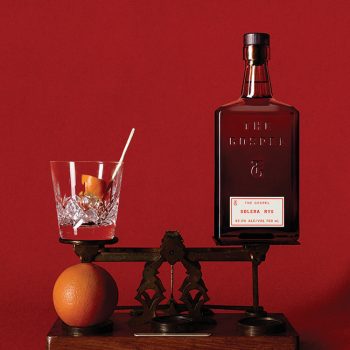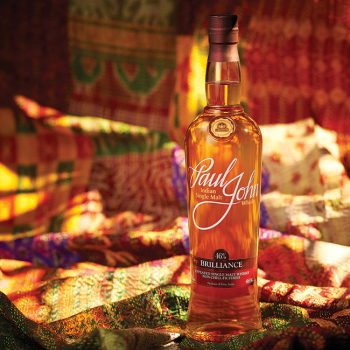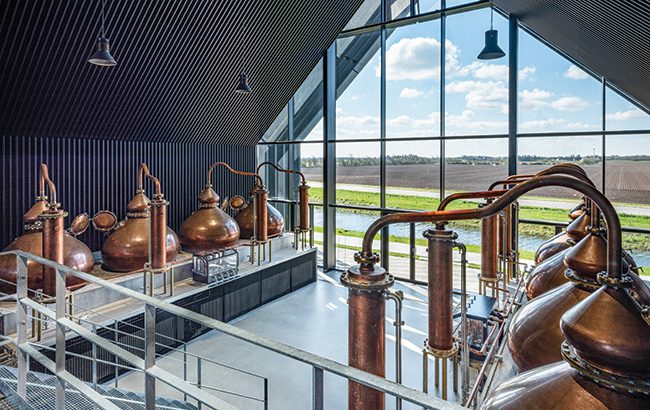This website uses cookies so that we can provide you with the best user experience possible. Cookie information is stored in your browser and performs functions such as recognising you when you return to our website and helping our team to understand which sections of the website you find most interesting and useful.
Why world whisky is growing in influence
By Luke McCarthyAway from the traditional heartlands of whisky production, brands in Asia Pacific and the Nordics are enjoying the freedom to use different materials and conditions to create interesting liquid.

*This feature was originally published in the August 2023 issue of The Spirits Business magazine.
The global fascination with whisky over the past two decades shows no sign of abating. While growth of the overall spirits market in volume consumption has been mixed in recent years, whisky has remained one of the leading lights.
The continued demand has been bolstered by the explosion in the number of distilleries from non-traditional countries producing their own unique and innovative whiskies. Well over 30 countries now produce whisky around the world. From Bolivia to Israel, Finland and South Africa, liquid made outside of traditional whisky-making countries, including Scotland, Ireland, the US, Canada and more recently Japan, is gaining broader market traction.
The global whisky category grew by 8% from 2021-2022, according to a recent report from IWSR Drinks Market Analysis. Figures show that the premium end of the market has been the key driver, and is forecast to increase by a 4% compound annual growth rate until 2027. With most new world producers positioning themselves at the premium-and-above segment, it’s little wonder that they’re finding an enthusiastic audience.
 “I don’t see my consumer as just being a whisky consumer. I see my consumer as a new-to-whisky consumer,” says Andrew Fitzgerald, co-founder of The Gospel Whiskey. The Melbourne distillery is one of Australia’s larger producers, and specialises in making high-quality rye and American-style whiskey. “Our consumer base is made up of more women, and is considerably younger than the standard whisky demographic. We’re definitely finding more success at winning over that growing pocket of the market.”
“I don’t see my consumer as just being a whisky consumer. I see my consumer as a new-to-whisky consumer,” says Andrew Fitzgerald, co-founder of The Gospel Whiskey. The Melbourne distillery is one of Australia’s larger producers, and specialises in making high-quality rye and American-style whiskey. “Our consumer base is made up of more women, and is considerably younger than the standard whisky demographic. We’re definitely finding more success at winning over that growing pocket of the market.”
Australia has produced whisky near-continuously for more than 160 years. But in the 1990s, a handful of microdistilleries emerged, such as Lark, Sullivans Cove, and Bakery Hill, inspiring a small-scale distilling boom, and placing the country at the front rank of new world whisky producers. Scottish single malt was the main influence on the early producers, but Australia now has upwards of 120 distilleries producing everything from rye, corn, wheat, and blended whiskies.
Clear leader
A smaller segment of larger, well-capitalised distilleries are now moving into exports as well. Starward Whisky, backed by Diageo’s startup accelerator business Distill Ventures, is the clear leader on that front, with an estimated 50% of the export trade, according to Starward founder David Vitale. But their success is now emboldening others, like The Gospel Whiskey, to follow.
“We now export to a number of markets, but we’re just feeling them out at the moment,” says Fitzgerald. “We’ve got people like Starward forging ahead with a good-quality product, and as long as we continue to keep the standard as high as it currently is there’s going to be substantial growth for Australian whisky moving forward.”
Head across the Tasman Sea to neighbouring New Zealand, and the growth story of the new world whisky category continues. Just under 20 distilleries are making whisky in the country. But unlike in Australia, where smaller distilleries producing under 20,000 litres per annum well outnumber larger producers, New Zealand whisky makers have the export market firmly in their sights.
“New Zealand whisky distillers have a really strong appetite for going global quite quickly,” says Greg Ramsay, founder of the New Zealand Whisky Collection. “We don’t have a big domestic market, but we know that quality New Zealand products have a huge following all around the world.”
Ramsay points to Pōkeno, Scapegrace, Cardrona, and his own newly constructed distillery inside the Speights Brewery as evidence of the shift towards larger production volumes. “With New Zealand Whisky Co, we’ve already been into a lot of international markets, and never had a problem selling our whisky. But now we’re looking to focus on markets where Scotch has been prevalent and dominant for a long time – France, the Netherlands, Germany. We find people are more interested and open to new world whisky in those places.”
When consumers do get around to tasting whiskies from these non-traditional countries, what sets them apart?
“The beauty of the new world whisky landscape is its ability to allow more freedom of expression. We’re OK with being outside the pocket of what to expect flavour-wise,” says Fitzgerald.
The Gospel whiskies share several common traits with traditional American straight rye whiskies but differ in their use of 100% unmalted rye sourced from a single farm. Australian ex-wine casks are also frequently used in The Gospel’s ‘Project’ releases in what has become a noted Australian hallmark thanks to Starward’s focus on red wine cask maturation.
Australian and New Zealand distillers are also using native wood to mature their spirit, and even smoke and malt their grain. Ramsay points to New Zealand whiskies like Thomson Whisky’s Manuka Smoked Single Malt and Pōkeno Totara Cask, the latter finished in a native totara wood barrel.
“That’s definitely what sets apart whiskies from Tasmania, New Zealand, or Kavalan in Taiwan or Paul John in India,” says Ramsay. “We’re not just making ex-Bourbon cask-matured Scottish-style whiskies. We’re all having a lot of fun, and creating new flavours, which is great.”
Taiwan’s Kavalan Distillery has become one of the biggest whisky success stories in Asia Pacific. Founded in 2005 by beverage company the King Car Group, Kavalan has won several major awards and pushed into key markets worldwide.
“Kavalan stands out from traditional Scottish single malt producers due to Taiwan’s tropical climate, which accelerates maturation, resulting in unique flavour profiles,” says Britney Chen, Kavalan’s global PR officer. “Yilan, where Kavalan is located, experiences hot summers and cool winters, which play a crucial role in the maturation process through extraction and oxidation.”
She continues: “Kavalan’s success reflects the openness of whisky enthusiasts to explore unique flavours and appreciate distilleries outside of the traditional whisky-producing regions.”
Elsewhere in the region, India is experiencing a remarkable boom in whisky production and consumption. India’s complex alcohol market hasn’t prevented it from becoming the leading country in Asia Pacific for whisky consumption.
 Cheaper blended whiskies have long been the dominate article there. But with the arrival of Amrut (2005), Paul John (2012), and Rampur (2016), and with a climate like Taiwan’s, which lends itself to accelerated ageing, sales of premium Indian single malts have taken off. The fastest-growing category in Indian whisky is single malt, according to Asa Abraham of John Distilleries, producer of Paul John Whisky.
Cheaper blended whiskies have long been the dominate article there. But with the arrival of Amrut (2005), Paul John (2012), and Rampur (2016), and with a climate like Taiwan’s, which lends itself to accelerated ageing, sales of premium Indian single malts have taken off. The fastest-growing category in Indian whisky is single malt, according to Asa Abraham of John Distilleries, producer of Paul John Whisky.
“There is a recognition of Paul John Indian Single Malt in traditional markets, where it has won over 300 awards and accolades for taste and quality,” says Abraham. “This has helped in expanding the category of Indian single malts in markets with strong whisky producing and consuming legacies.”
In recognition of this new landscape, forums and summits are coming online to promote the category. The World Whisky Forum, founded in 2016, celebrates the producers challenging the status quo. The most recent iteration was held in late 2022 at Denmark’s Stauning Distillery. Denmark’s leading malt and rye whisky producer, Stauning was founded by nine friends in 2005, and is itself a leading proponent of the new world whisky movement.
Karen Taylor, Stauning’s digital marketing manager, says the forum saw around 70 people come together from whisky distilleries of all sizes from all over the world. “We are proud to be a part of the first wave of European distilleries,” she says. “For us, it is encouraging evolution outside of existing categories that is resulting in offering consumers a more diverse selection of flavours and styles of whisky.”
While Stauning, which is also backed by Distill Ventures, is much closer to the UK in terms of distance and climate, its approach is very much rooted in keeping things local and sustainable. “The founders wanted to make a whisky that truly spoke of the region, its people, and for lack of a better word, its terroir,” says Taylor.
Innovative design
All the grain used in Stauning’s production comes from just two farms within 25 kilometres of the distillery. That grain is then floor-malted using the distillery’s specially designed Stauning Malt Turner, an innovative design that is now being installed in production facilities in Germany, Norway, and even in Scotland.

Taylor explains: “We smoke our malted barley and rye at certain times of the year. We only use local ingredients – local peat and local heather. It’s a pain in the ass – Heather likes to burn rather than smoke. But it gives a unique local character.”
Taylor says that the coming together and collaboration between traditional and up-and-coming producers can only benefit the whisky category as a whole moving forward.
“We see the ongoing growth of new distilleries as a very positive thing. They provide more voices to build a strong category, and act to challenge and inspire the more established and traditional whisky regions such as Scotland, Ireland, America, and Japan.”
What sets Taiwanese whisky apart from other whisky styles?
Britney Chen – regional brand ambassador and global PR officer, Kavalan
“When it comes to whisky ageing there are actually two processes required – extraction (which needs heat) and oxidation (needing the cold).
“While Taiwan is produced in a unique subtropical climate, where the heat and humid environment accelerates the maturation process and results in a faster ageing period compared with traditional whisky-producing regions, Kavalan’s cooler winters play a key role. An enhanced oxidation process – which is the breathing in of the whisky when it sleeps – infuses the whisky with oxygen. The oxygen combines with the flavours extracted from the wood to lock flavour compounds into the spirit, giving Kavalan its highly complex layers of taste and aroma.
“The quality of water used in whisky production is crucial, and Yilan, in Taiwan, is known for its pristine water sources. Kavalan whisky benefits from the abundant water from the Snow Mountain, which is rich in minerals and contributes to the whisky’s smoothness and purity.
“These factors collectively result in a diverse range of styles and flavours that sets Kavalan whisky apart in the ever-expanding world of whisky.”

